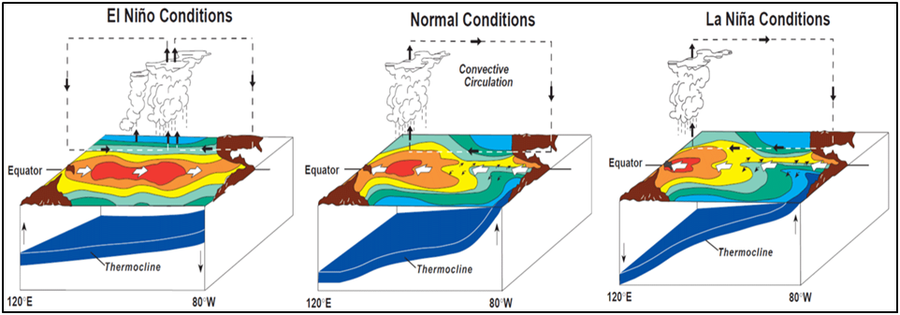Why in the News?
Hyderabad-based Indian National Centre for Ocean Information Services (INCOIS) has developed a new product to predict the emergence of El Nino and La Nina conditions.
What’s in Today’s Article?
- About INCOIS (Meaning, Objective, Activities)
- About ENSO (Meaning, El Nino, La Nina, etc.)
- New Product to Forecast El Nino and La Nina
About INCOIS:
- Indian National Centre for Ocean Information Services (INCOIS) is an autonomous organization, established in 1999, under the Ministry of Earth Sciences.
- It is a unit of the Earth System Science Organization (ESSO).
- Objective: To provide ocean data, information and advisory services to society, industry, the government and the scientific community.
- Activities of INCOIS Include:
- Provides round-the-clock monitoring and warning services for the coastal population on tsunamis, storm surges, high waves, etc.
- Provides daily advisories to fisher folk to help them easily locate areas of abundant fish in the ocean while saving on both fuel and time used to search for the same.
- Short term (3-7 days) Ocean State Forecasts (waves, currents, sea surface temperature, etc.) are issued daily.
- Deploys and maintains a suite of Ocean Observing Systems in the Indian Ocean to collect data on various oceanic parameters to understand the processes in the ocean and to predict their changes.
What is ENSO (El Nino and Southern Oscillation)?

- ENSO is one of the most important climate phenomena on earth due to its ability to change the global atmospheric circulation, which in turn, influences temperature and precipitation across the globe.
- Though ENSO is a single climate phenomenon, it has three states, or phases, it can be in:
- El Nino:
- This phase is characterized by unusually warm sea surface temperatures in the central and eastern equatorial Pacific.
- El Nino typically leads to altered weather patterns around the world, including increased rainfall in the southern United States and Peru, and drought conditions in Australia, Indonesia, and India.
- It can also affect marine life due to changes in nutrient availability in the ocean.
- La Nina:
- This phase features unusually cold sea surface temperatures in the central and eastern equatorial Pacific.
- La Nina generally causes the opposite weather effects of El Nino.
- For instance, it can lead to increased rainfall in Australia and Indonesia, and drier conditions in the southwestern United States.
- La Nina events can also influence hurricane activity in the Atlantic Ocean, often increasing the number of hurricanes.
- Neutral:
- In this phase, sea surface temperatures and atmospheric conditions in the equatorial Pacific are near average.
- This phase is also sometimes referred to as ENSO-neutral.
- During this phase, the global weather patterns are more stable and not significantly influenced by the extreme conditions seen during El Nino or La Nina.
New Product to Forecast El Nino and La Nina:
- Hyderabad-based Indian National Centre for Ocean Information Services (INCOIS) has developed a new product to predict the emergence of El Nino and La Nina conditions.
- Known as Bayesian Convolutional Neural Network (BCNN), the new product uses the latest technologies such as Artificial Intelligence (AI), deep learning, and machine learning (ML) to improve forecasts related to the ENSO phases.
Working of BCNN:
- The model predicts El Nino or La Nina by observing slow changes in the ocean and how they interact with the atmosphere.
- This interaction allows enough time to make early forecasts.
- The prediction uses the Nino3.4 index, which helps identify the different ENSO phases.
- This index is calculated by averaging the sea surface temperature (SST) anomaly in a specific part of the central equatorial Pacific, ranging from 5°N to 5°S latitude and 170°W to 120°W longitude.









